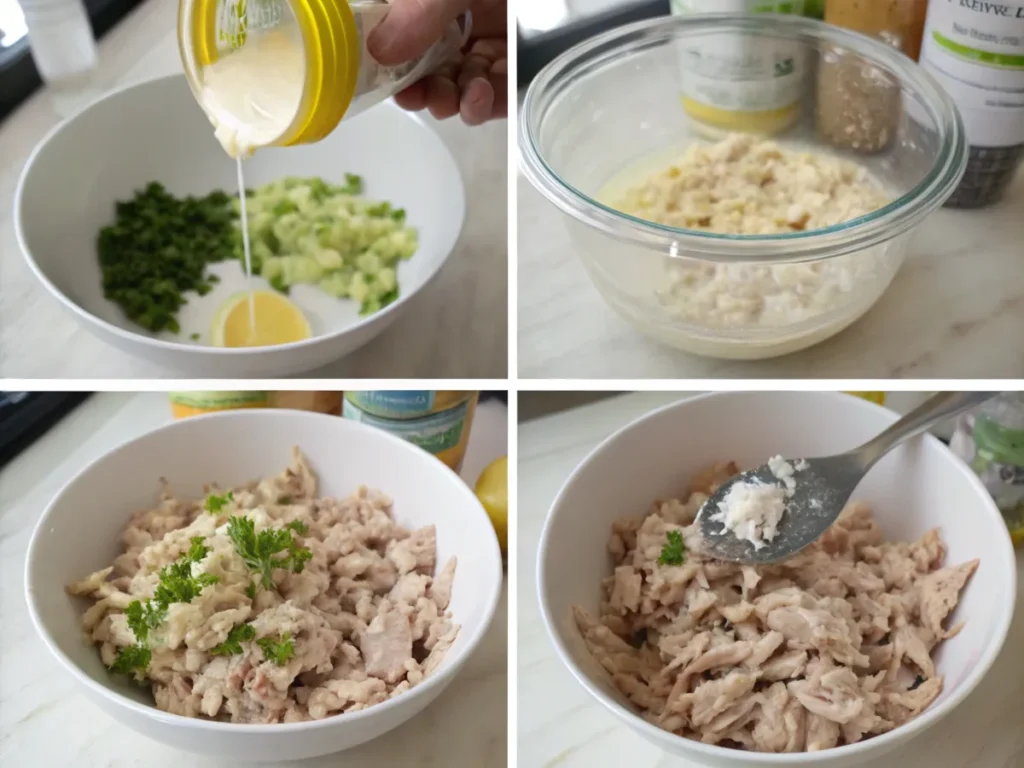Tuna salad is one of those classic comfort foods that always seems to hit the spot—whether it’s stuffed into a sandwich, served on crackers, or scooped straight out of the bowl (no judgment here). But if you’ve ever found yourself staring into your fridge, wondering if that leftover is still safe to eat, you’re not alone. So, how long is tuna salad good for? Let’s break it all down, step by step, and cover everything you need to know about storing it, keeping it fresh, and avoiding spoilage disasters.
Table of contents
How Long Does Tuna Salad Last?
Let’s get straight to the point: tuna salad typically lasts 3 to 5 days in the fridge. Yep, that’s it. No magical “keep it fresh forever” solution exists. This time frame assumes you’re storing it properly in an airtight container at a safe refrigerator temperature (around 40°F or lower). Beyond that, you’re playing a risky game with your stomach.

But what if you don’t even remember when you made it? Or maybe you’re unsure because you threw it together while chatting on the phone and forgot to date the container? (Been there!) Let’s talk about the key factors that affect how long your tuna salad will stay good.
Factors That Affect Shelf Life
Several things can impact how long your tuna salad holds up. While 3 to 5 days is the general rule, these details might push you to the shorter or longer end of that range:
- The Ingredients You Use:
The type of dressing plays a big role here. Tuna salad made with mayo can spoil faster than one made with Greek yogurt, thanks to mayo’s higher fat content and lower acidity. Adding chopped eggs? They can also shorten the salad’s lifespan. - How You Store It:
Leaving tuna salad uncovered or loosely covered in the fridge is a bad move—it dries out and invites bacteria. (Think of it like leaving the door open to bugs at a summer picnic!) Using an airtight container is your best bet to lock in freshness. - The Temperature of Your Fridge:
A fridge that hovers around 40°F is perfect for food safety. But if your fridge is running a little warm (hello, crowded shelves!), you might want to check the tuna salad sooner rather than later.
Best Ways to Store Tuna Salad

Okay, so you’ve got some leftovers, and you want to make sure it stays edible for as long as possible. Storage is everything. Here’s how to do it right:
Use Airtight Containers
If you’re still using those flimsy takeout containers from last week’s sushi night, it’s time to upgrade. Airtight containers are your new best friend. They keep air out (air = bacteria = bad) and keep the salad fresh. I like glass containers because they don’t hold onto odors the way plastic does. Ever had tuna salad that tastes like last week’s spaghetti? No thanks.
Refrigeration Tips
Now, let’s talk about your fridge. It’s the VIP section where your tuna salad hangs out until you’re ready to eat it. Keep these tips in mind:
- Store the container on the top shelf or in the coldest part of your fridge.
- Don’t leave the container sitting on the counter while you prep lunch for tomorrow. Pop it straight into the fridge as soon as you’re done serving.
- If you’ve got a fridge thermometer (they’re cheap and totally worth it!), double-check that your fridge is set to 40°F or lower.
Pro Tip: If your tuna dish is going into a lunchbox for work or school, use an ice pack to keep it cold until it’s time to eat.
Separate Ingredients Before Storing
This is a game-changer if you’re meal-prepping! Instead of mixing everything together, keep the components separate until you’re ready to eat. For example, store the tuna and dressing in one container and the veggies or extras (like celery or onions) in another. That way, the salad stays fresher longer and doesn’t get all soggy.
“Tuna salad is one of those dishes that tastes even better the next day—if it’s stored the right way! A little prep goes a long way in keeping it fresh and delicious.”
How to Tell If Tuna Salad Has Gone Bad
Nobody wants to deal with food poisoning, so it’s crucial to know when your tuna salad has overstayed its welcome. Sometimes, it’s obvious—but other times, the signs can be sneaky. Here’s how to know for sure.
Changes in Smell, Texture, and Color
- Smell: If your tuna salad smells sour, fishy (and not in the good, fresh fish way), or just plain “off,” it’s time to toss it.
- Texture: A slimy or sticky texture is a big red flag. Tuna salad should feel creamy, not gooey.
- Color: Discoloration is another warning sign. If it looks dull, gray, or has weird spots, don’t even risk it.
Ingredient-Specific Spoilage Signs
Different ingredients in tuna dish can go bad in different ways. Here’s what to watch out for:
- Mayo-based dressing: If it starts to separate or develop a greasy film, that’s not normal.
- Eggs: Hard-boiled eggs can give off a sulfuric smell when they’re past their prime.
- Veggies: Celery and onions can turn mushy and lose their crunch, which is a sign they’re on the downhill slide.
The “When in Doubt, Throw It Out” Rule
Let me say it louder for the folks in the back: If you’re unsure whether your tuna salad is safe to eat, throw it out. I know, wasting food sucks, but your health is way more important than a couple of scoops of questionable salad.
“Food safety isn’t just about avoiding a bad stomachache—it’s about protecting yourself from serious illnesses. Always err on the side of caution when it comes to leftovers.”
Tips to Keep Tuna Salad Fresh Longer
If you love tuna as much as I do, you’ll want to squeeze every last day of freshness out of it. Here are some clever hacks to make it last:
Hack 1: Add Acidity (Lemon Juice or Vinegar)
This is one of my favorite tricks! A little squeeze of lemon juice or a splash of vinegar can work wonders. Why? Because acidity helps slow down bacterial growth, meaning your tuna stays fresher for longer. Plus, it adds a bright, tangy flavor that makes the dish even tastier.

Hack 2: Divide Into Smaller Portions
Instead of storing one giant container of tuna salad, divide it into smaller, single-serving portions. This reduces the amount of air exposure every time you open a container, which helps keep the salad fresh. Bonus: It’s way easier to grab and go when you’re packing lunch.
Hack 3: Chill Immediately After Preparation
Don’t leave your tuna salad sitting out while you clean up the kitchen or answer a phone call. Pop it into the fridge as soon as it’s made. Even just 30 minutes at room temperature can give bacteria a chance to grow.
Can You Freeze Tuna Salad?
Freezing tuna salad is one of those ideas that sounds great in theory—after all, who doesn’t love the convenience of meal prepping? But let’s get real for a second: not every food handles freezing like a champ. Tuna salad? It’s kind of a mixed bag. You can freeze it, but it’s not always ideal. Let’s break it down so you can decide if it’s worth the freezer space.
How Freezing Affects Tuna Salad
Here’s the deal: freezing tuna salad can significantly impact its texture and flavor, especially if it’s mayo-based. Why? Because mayo doesn’t freeze well. When frozen, mayo tends to separate into its oily and watery components, which can make your salad a bit of a gloopy mess once it thaws. (Yikes, right?)
If you’ve used a different dressing, like Greek yogurt, you’ll probably have better luck. Yogurt is less prone to separating, so the texture of your salad might hold up a little better. Just keep in mind that any veggies in the salad, like celery or onions, might lose their crunch after thawing.
Steps for Freezing Tuna Salad Properly
If you’re determined to freeze that leftover tuna salad, here’s how to do it the right way to minimize the damage:
- Use a Freezer-Safe Container:
Airtight, freezer-safe containers or resealable freezer bags are your best bet. Make sure there’s as little air as possible in the container before sealing it up. If you’re using a bag, press out any extra air—it’s like giving your tuna salad a cozy blanket! - Label and Date It:
Trust me, you don’t want to play the “What is this mystery blob in the freezer?” game. Use a permanent marker to label the container with the date you’re freezing it. - Freeze in Small Portions:
Smaller portions freeze and thaw more evenly than one giant batch. Plus, this makes it easier to defrost only what you need. - Thaw Safely:
When you’re ready to eat the tuna salad, move it to the fridge and let it thaw slowly overnight. Don’t thaw it on the counter—room temperature is the perfect breeding ground for bacteria.
How Long Frozen Tuna Salad Will Last
Frozen tuna salad can last 1 to 2 months in the freezer, but don’t wait too long to use it. The longer it sits, the more the texture and flavor will degrade. And let’s be honest; nobody wants to bite into tuna mix that tastes like it’s been hanging out in the freezer aisle for six months.
FAQs About Tuna Salad Storage
When it comes to tuna salad, people always seem to have the same questions. Let’s tackle some of the most common ones so you’ll never be left scratching your head again.
What Happens if Tuna Salad Is Left Out Too Long?
Short answer? It’s bad news. Tuna salad left out at room temperature for more than two hours falls into what food safety experts call the “danger zone” (40°F to 140°F). In this range, bacteria grow like, doubling every 20 minutes. If it’s been sitting out for more than two hours—or even just one hour on a hot day—toss it. It’s just not worth the risk.
Can You Store Tuna Salad Without Refrigeration?
Not really. Unless you’re working with a shelf-stable alternative like canned tuna with no added dressing, tuna salad absolutely needs to be refrigerated. If you’re packing it for a picnic or road trip, use an insulated cooler with ice packs to keep it at a safe temperature.
Does the Type of Tuna Affect Storage Time?
Yes, it can! Tuna salad made with fresh tuna (like seared or poached tuna) might not last as long as one made with canned tuna because canned tuna has been preserved and pasteurized. If you’re working with fresh tuna, stick closer to the 3-day mark for safety.
Nutritional Information
Tuna salad isn’t just convenient—it’s packed with protein, too. But depending on your ingredients, the calorie count and nutrient profile can vary a lot. Here’s a general breakdown:
- Calories: A typical serving of tuna salad (around 1/2 cup) contains 200–300 calories.
- Protein: Thanks to the tuna, you’re looking at about 15–20 grams of protein per serving.
- Fat: The fat content largely depends on whether you use mayo or a lighter alternative like Greek yogurt. Mayo can add around 10–15 grams of fat, while yogurt keeps it closer to 2–5 grams.
Adjustments for Dietary Preferences
Want to tweak your tuna salad to suit your health goals? Here are some easy swaps:
- Lower Fat: Replace mayo with Greek yogurt, avocado, or a mix of both for a creamy, lower-fat option.
- More Fiber: Toss in some diced veggies like carrots, cucumbers, or bell peppers.
- Gluten-Free: Skip the bread and serve it over lettuce or in a lettuce wrap.
“Making small tweaks to your tuna salad recipe can transform it from a calorie-heavy indulgence into a nutrient-packed, guilt-free meal!”
Printable Storage and Freshness Tips Cheat Sheet
Here’s a handy summary of everything we’ve covered so far. Bookmark it, print it, or stick it on your fridge—you’ll never have to guess again.
| Storage Tip | Best Practice |
|---|---|
| Fridge Shelf Life | 3–5 days |
| Freezer Shelf Life | 1–2 months |
| Ideal Fridge Temperature | 40°F or lower |
| Signs of Spoilage | Sour smell, slimy texture, discoloration |
| Room Temperature Safety Limit | 2 hours (1 hour if it’s hot) |
| Hacks for Freshness | Add lemon juice, and divide into portions |
Wrapping It All Up
Tuna salad might not last forever, but you can enjoy it safely and deliciously for days with the right storage and a little know-how. Whether you’re meal prepping for the week, figuring out how to freeze it, or just trying to avoid food waste, the tips in this guide have covered you. So go ahead and make that batch of tuna salad. You’ve got this!
Have more food questions? Check out How Long Does It Take to Cook Frozen Meatballs in the Air Fryer or learn the story behind Why Is It Called “Marry Me Chicken Pasta?”.
Feel free to share your thoughts or tips in the comments below. Bookmark this guide, experiment with your recipe, and enjoy every bite of that perfectly stored tuna salad!

